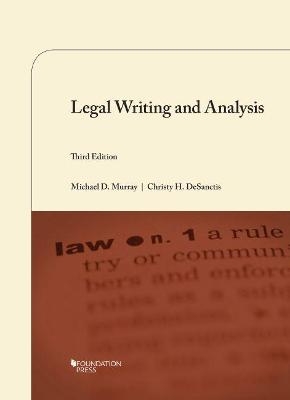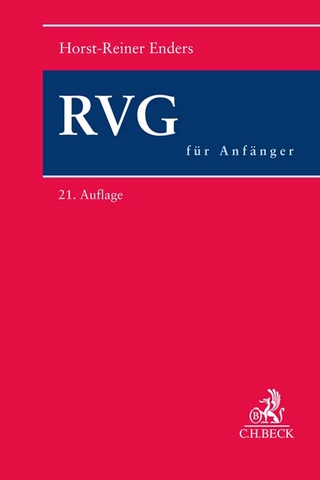
Legal Writing and Analysis
Seiten
2021
|
3rd Revised edition
West Academic Press (Verlag)
978-1-68467-538-8 (ISBN)
West Academic Press (Verlag)
978-1-68467-538-8 (ISBN)
Communicating about the law in writing, whether in emails, texts, or in team and group settings, will only increase in importance when there are fewer opportunities to explain yourself orally and in-person to clients, colleagues, bosses, and other decision makers. The authors have adapted and updated this text with these developments in mind.
CasebookPlus Softbound - New, softbound print book includes lifetime digital access to an eBook, with the ability to highlight and take notes, and 12-month access to a digital Learning Library that includes self-assessment quizzes tied to this book, leading study aids, an outline starter, and Gilbert Law Dictionary.
The third edition of Legal Writing and Analysis was written during the Covid-19 Corona Virus Pandemic of 2020. The practice of law and legal writing was already changing at a steady pace in the years leading up to the 2020 crisis, and the changes being wrought now in the "locked down, no human contact, remote and online" practice of law are currently being measured. The early polls indicate that a tectonic shift has occurred. The economic shockwaves resulting from the Covid-19 crisis are likely to contract the legal job market further. Law students and graduates who already possess practice-ready skills are going to be in demand. In addition, the Covid-19 crisis has opened everyone's eyes to the need to be able to practice law remotely and not in-person, and to the short- and possibly long-term need to deliver law instruction online. Communicating about the law in writing, whether in emails, texts, or in team and group settings, will only increase in importance when there are fewer opportunities to explain yourself orally and in-person to clients, colleagues, bosses, and other decision makers such as judges and governmental entities.
The authors have adapted and updated Legal Writing and Analysis with these developments in mind. The book is now organized according to the following principles:
The course materials are now organized as a blueprint to achieve the learning outcomes of the course.
Each learning outcome will be achieved through individual online modules designed to teach and develop the skills and information needed as the goal of the learning outcome.
Each online module will address the three dimensions of learning: to discover and learn the material, to discuss and critique the material, and to do or demonstrate the work involved in the topic of the module.
Each of the three dimensions of the module will be measurable.
In recognition of contemporary modes of legal communication, there is a new chapter on client letters, email, and texting, and a new chapter on rhetoric and professionalism in writing, online, and in social media.
The authors have reorganized the chapters to focus on the separate skills of rule synthesis in Rule Sections, explanatory synthesis in Explanation Sections, and how all of this fits within the T-R-E-A-T format.
The authors have continued to increase the visualization of the material in the chapters and modules through callout boxes, charts, tables, and summaries of the contents.
The authors have doubled down on providing samples of each part of the practitioner writing discussed in each chapter and module.
This new edition will train students—future lawyers—to be ethical and professional issue-spotters, analysts, counselors, problem-solvers, and communicators working to advance their clients' interests in an online, hybrid, or in-person legal practice world.
CasebookPlus Softbound - New, softbound print book includes lifetime digital access to an eBook, with the ability to highlight and take notes, and 12-month access to a digital Learning Library that includes self-assessment quizzes tied to this book, leading study aids, an outline starter, and Gilbert Law Dictionary.
The third edition of Legal Writing and Analysis was written during the Covid-19 Corona Virus Pandemic of 2020. The practice of law and legal writing was already changing at a steady pace in the years leading up to the 2020 crisis, and the changes being wrought now in the "locked down, no human contact, remote and online" practice of law are currently being measured. The early polls indicate that a tectonic shift has occurred. The economic shockwaves resulting from the Covid-19 crisis are likely to contract the legal job market further. Law students and graduates who already possess practice-ready skills are going to be in demand. In addition, the Covid-19 crisis has opened everyone's eyes to the need to be able to practice law remotely and not in-person, and to the short- and possibly long-term need to deliver law instruction online. Communicating about the law in writing, whether in emails, texts, or in team and group settings, will only increase in importance when there are fewer opportunities to explain yourself orally and in-person to clients, colleagues, bosses, and other decision makers such as judges and governmental entities.
The authors have adapted and updated Legal Writing and Analysis with these developments in mind. The book is now organized according to the following principles:
The course materials are now organized as a blueprint to achieve the learning outcomes of the course.
Each learning outcome will be achieved through individual online modules designed to teach and develop the skills and information needed as the goal of the learning outcome.
Each online module will address the three dimensions of learning: to discover and learn the material, to discuss and critique the material, and to do or demonstrate the work involved in the topic of the module.
Each of the three dimensions of the module will be measurable.
In recognition of contemporary modes of legal communication, there is a new chapter on client letters, email, and texting, and a new chapter on rhetoric and professionalism in writing, online, and in social media.
The authors have reorganized the chapters to focus on the separate skills of rule synthesis in Rule Sections, explanatory synthesis in Explanation Sections, and how all of this fits within the T-R-E-A-T format.
The authors have continued to increase the visualization of the material in the chapters and modules through callout boxes, charts, tables, and summaries of the contents.
The authors have doubled down on providing samples of each part of the practitioner writing discussed in each chapter and module.
This new edition will train students—future lawyers—to be ethical and professional issue-spotters, analysts, counselors, problem-solvers, and communicators working to advance their clients' interests in an online, hybrid, or in-person legal practice world.
| Erscheinungsdatum | 01.07.2021 |
|---|---|
| Reihe/Serie | Coursebook |
| Verlagsort | Minnesota |
| Sprache | englisch |
| Maße | 186 x 254 mm |
| Gewicht | 795 g |
| Themenwelt | Recht / Steuern ► EU / Internationales Recht |
| Recht / Steuern ► Privatrecht / Bürgerliches Recht ► Berufs-/Gebührenrecht | |
| ISBN-10 | 1-68467-538-3 / 1684675383 |
| ISBN-13 | 978-1-68467-538-8 / 9781684675388 |
| Zustand | Neuware |
| Haben Sie eine Frage zum Produkt? |
Mehr entdecken
aus dem Bereich
aus dem Bereich
Bürgerliches Recht, Handelsrecht, Gesellschaftsrecht, …
Buch | Softcover (2024)
Franz Vahlen (Verlag)
39,80 €
mit Gerichtskostengesetz, Gesetz über Gerichtskosten in …
Buch | Softcover (2024)
dtv Verlagsgesellschaft
15,90 €


